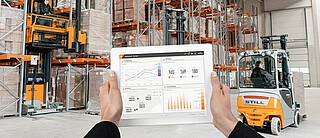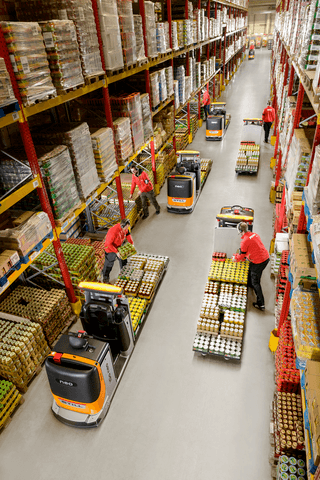How will industry 4.0 affect warehouse fleet management?

The warehousing and logistics industry has been evolving since the first industrial revolution back in the 1700s. Far from the days of steam-powered technology, we’re now seeing the output of Industry 4.0 and data-driven businesses. This new phase of industry brings together human operators and management with automation, machine-learning and real-time data.
Nowhere has this output been more obvious than through the developments at tech and logistics giant Amazon. Away from their online order and fulfilment service, Amazon have taken a step into the high street with the launch of their Amazon Fresh stores in the UK. Using “Just Walk Out technology,” shoppers can scan a code linked to their Amazon account on the way into the store then simply grab what they want and go, without scanning or checking out a single item. A complex combination of deep learning, sensors and cameras detect what people pick up and simply bills their Amazon account.
The emergence of Amazon Fresh and its online grocery shopping offer isn’t the only change on the high street that’s come about in recent months. Shopping giants Debenhams, Dorothy Perkins and GAP have all announced moves from traditional stores to purely online sales and fulfilment from centralised distribution centres. While these changes have no doubt been accelerated by the recent pandemic restrictions, the growth of online ordering in recent years has been fuelled by Industry 4.0 as customer expectations continued to increase.
Ultimately, these expectations are what is driving changes in warehouses, their vehicle fleets, and how they operate. Customers, both B2C and B2B, expect quick deliveries, easy returns and effortless transactions. Delays, wrong or damaged orders, out of stock items…there is less tolerance for mistakes because expectations continue to be pushed higher by the rapid developments in the logistics industry.
So, how will these changes affect warehouse fleet management?
Increased use of intelligent trucks and changing operator skills
Busier warehouses – both in terms of orders being processes and vehicles on the floor – brings more risk of collisions and accidents. As warehouse fleets grow in size, we’re seeing increased need for spatial awareness in the vehicles themselves, which is where intelligent trucks come into play.
Semi-automated fleet options – like the STILL iGo neo – will become more prevalent in Industry 4.0 as it seeks to become as effective as possible, increasing worker efficiency and order process speed and minimising unexpected downtime and damages due to human error.
A side-effect of this we’d expect to see would be a diversification of fleet service personnel. Service is changing in Industry 4.0. While engineers will still be expected to fix faulty breaks or damaged tyres, they’re also likely to be asked to fix an automated system which has stopped working or a faulty sensor.

Cloud-based fleet data management
The shift to Industry 4.0 has brought the developments in software into the warehouse and fleet management software has become more important than ever. If you have a vehicle fleet, you’ll need software to get the most out of it. The full roll out of 5G across the UK has brought with it unrivalled connectivity and allows for the application of web-based management software and real-time service.
We expect to see fleet management software driving vehicle efficiency and increasing productivity in Industry 4.0. Operations and fleet management software to give an overview of operations (like STILL’s Fleet Manager 4.x and the STILL neXXt fleet system) not only ensure the most efficient running of vehicles but allow managers to identify issues with their fleet before they become problems that cause downtime and vehicle outage. Before these developments in industry, there was often no way to identify an issue with a vehicle until it broke down and became a costly repair. These days, software management means that fleets will be monitored in real-time and services and fixes scheduled accordingly.
Increasingly busy warehouses with ever-tighter delivery deadlines mean that an overview of the fleet isn’t just something that allows for better management. It’s something that is essential for keeping modern logistics systems running at the rate they need to.
Going electric
The rise of Industry 4.0 has coincided with a renewed focus on renewable energy sources and moves away from combustion engines and fossil fuels, particularly here in the UK. With the UK Government’s Net Zero initiative making red diesel prohibitively expensive for most sectors in 2030, it’s likely that more and more warehouse fleets will move away from diesel-powered vehicles and bring in more electric-powered options.
The move to electric is unlikely to be a uniform one, with many industries still utilising diesel-powered vehicles for more arduous tasks, but with interconnectivity a key element of Industry 4.0, the benefits of an electric fleet are likely to be felt in every sector.
Automation systems
Automation is a key component of Industry 4.0, and we’re already seeing this become a feature in some of the more complex warehouse operations.
Ocado have become one of the first operators in the UK to utilise robot packing in an automated distribution centre in London, where customer orders are picked from a product “hive” by a system of robot pickers. It’s estimated that this system can fulfil a 50-item order five minutes with a 99% accuracy rate. Orders are then transferred to human operators who pack the groceries and ship them nationwide. This is just one example of how automated systems are being utilised to fill time-critical, high-volume orders but it’s likely something that we’ll see more of as this technology becomes more widely available.
However, these developments don’t always come without their hazards and removing the human element doesn’t always guarantee the avoidance of accidents. The Ocado packing system, held as a model for many bulk-order fulfilment centres, was recently forced to shut down temporarily after a collision between three robotic picking arms caused a fire which damaged the packing grid and loading bays. It highlights the importance of teams behind the machines when things go wrong.
Customised hard and software solutions will become more prevalent as businesses seek solutions to their specific needs. Whether that’s a complex system of robot packagers, or a bespoke warehouse fleet tailored to daily operations or specific operating spaces. There is already a broad range of full and semi-automated trucks on the market and we’re seeing increasing demand for them in industry.
Given the efficiencies gained and the progress being made through Industry 4.0, there’s no going back from this latest industrial revolution and the applications for fleet management are already proving vital in a fast-moving and ever-changing sector.
Comments
No comments
Subscribe to our blog!
As soon as a new article is published, we will notify you! You can unsubscribe at anytime.

Leave a comment